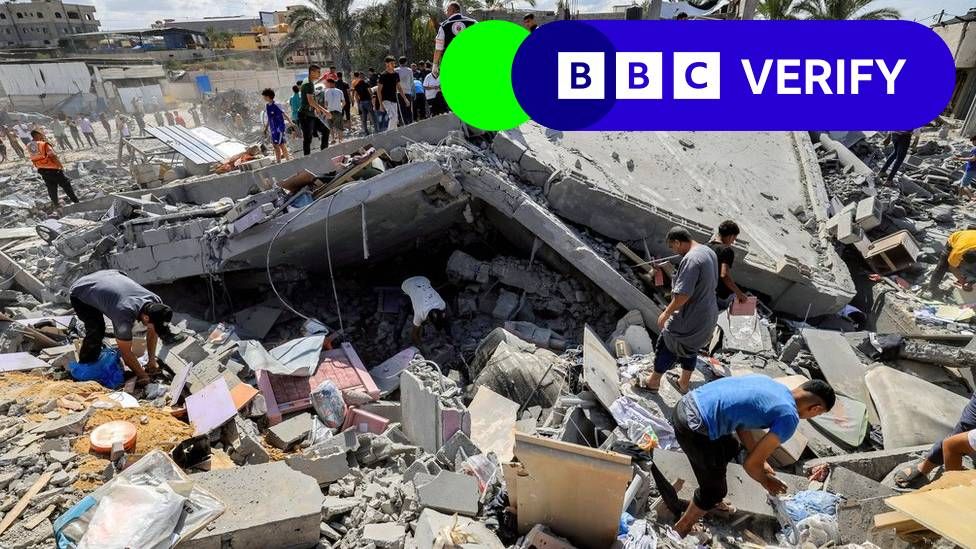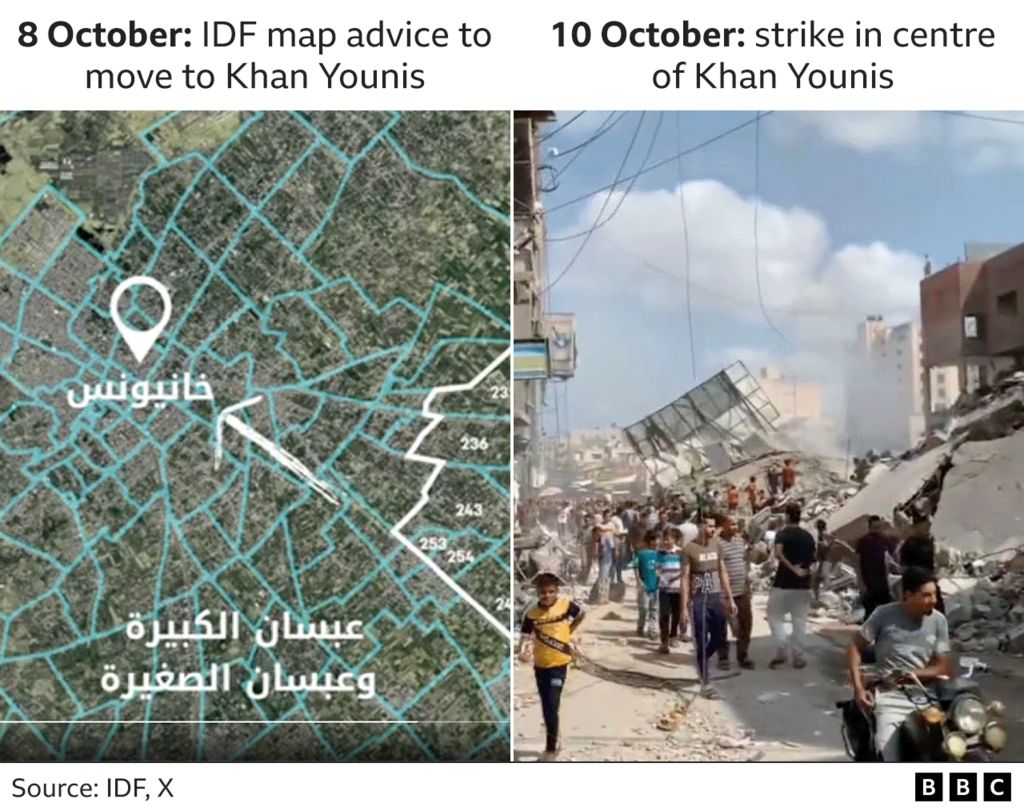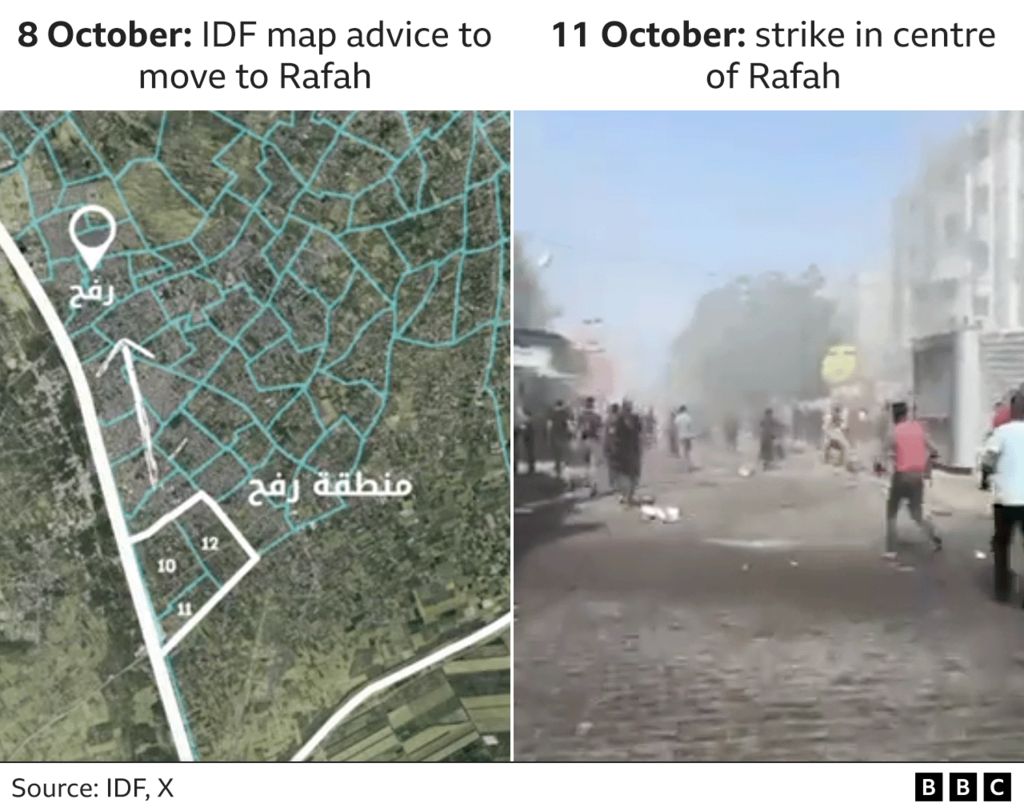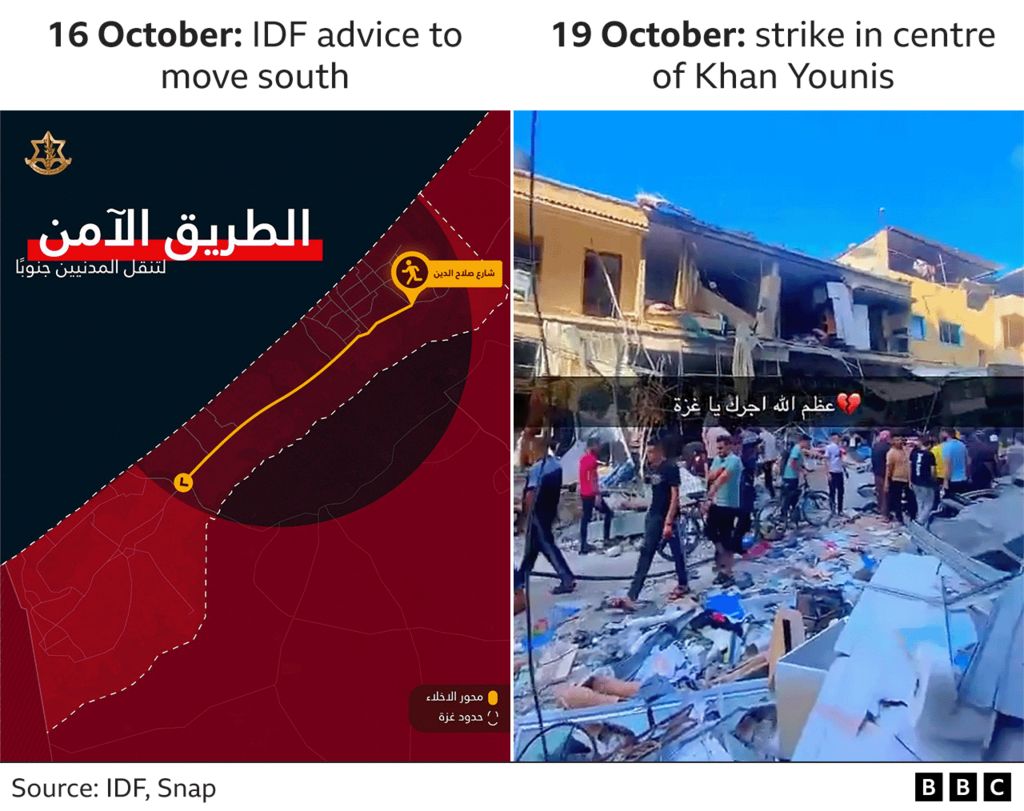
People pick through the rubble in the aftermath of a strike in Khan Younis on the 19 October. GETTY IMAGES
Since the Israeli military issued the first of several instructions for civilians to evacuate north Gaza, hundreds of thousands of Gazans have moved to the south of the strip. But the south has continued to come under Israeli bombardment, leading the UN and other aid organisations to warn that nowhere in Gaza is safe for civilians.
To better understand the risk to civilians in south Gaza, BBC Verify has identified and analysed four specific instances of strikes in that region. We also looked at some of the warnings and evacuation instructions that were issued to Gazan civilians, including some advising them to move to certain areas in the south.
Some of these warnings were accompanied by maps with arrows pointing to vaguely defined areas to move towards. Three strikes we examined hit within, or close to, those areas in the days after the warnings were issued.
The IDF has said that it communicates with Gaza’s residents in a variety of ways, including leaflet drops, social media posts in Arabic, and warnings issued through civilian and international organisations. In this piece we have examined the IDF’s instructions posted on social media.
Khan Younis – 10 October
The IDF said on 10 October that overnight its fighter jets had struck more than 200 targets in Rimal in the north, and Khan Younis in the south. The BBC has examined a strike on that day in central Khan Younis to understand the location and the scale of the damage. Video footage published in the aftermath of the attack shows rubble and collapsed buildings in the city centre. We have verified its location using visual clues such as the minaret of the Grand Mosque in Khan Younis.
More
We have also examined photos showing destroyed buildings, and people picking through what remains of cars and homes. We know the photos show the same location as that seen in the video because the same pharmacy sign can be seen in both. We also used reverse image search to check that the photos were not from an earlier incident.
On the morning of 8 October, IDF spokesperson Avichay Adrae had posted a warning on X (formerly known as Twitter) in Arabic, giving instructions to residents of various areas in Gaza to leave their homes and move elsewhere for their safety.
While evacuation zones have often been clearly delineated, the destinations residents have been told to head to have often been much more vague.
In this instance, those living in the neighbourhoods of Abasan al-Kabira and Abasan al-Saghira, a few kilometres south-east of central Khan Younis, were told in the 8 October tweet to go to “Khan Younis city centre.”
The map included in the tweeted video for those living in the two neighbourhoods highlights their current residencies, and is labelled with an arrow simply pointing in the direction of Khan Younis.
We cannot discount the possibility that there were then subsequent different instructions, but the BBC has not found any evidence of this.

Rafah – 11 October
The BBC has verified that there was another strike the next day, further south near the border with Egypt. This 11 October strike hit Nejmeh Square in the centre of Rafah. The BBC looked at a video posted to social media showing destruction in the strike’s aftermath. Using available images of the square before the attack, we were able to identify the shape of the buildings as that of Nejmeh square.
The warning, issued on 8 October by the IDF, also contained an instruction for residents of Rafah, telling them to immediately go to the shelter in Rafah city centre “for your safety”.
The map in the video for those living in the Rafah neighbourhoods contains an arrow directing residents towards “Rafah”.
The BBC analysed all of the IDF social media warning posts in Arabic it is aware of in this time period. It has not been able to find evidence of any subsequent different instructions, but that does not eliminate the possibility that others were issued.

Khan Younis – 19 October
Eight days on, back in Khan Younis, there was another strike – on Gamal Abdel Nasser Street. We verified this by looking at videos of the collapsed buildings in one of the city’s main thoroughfares. By matching the shape of the buildings in the video, with those in other still images of the same location, we were able to verify this was the same place.
Additional footage from the aftermath shows bodies of the dead and injured being pulled out of rubble and taken to nearby Nasser hospital.
The IDF had issued a warning on 16 October for residents of Gaza City to move south to Khan Younis if “your safety and the safety of your loved ones are important to you”.
Again, there is a possibility that there were further instructions that were different, but we have not found any evidence of this.

Camps in central Gaza – 17, 18 and 25 October
Further north, in central Gaza, there are four refugee camps. The BBC has verified strikes on two of them. Social media footage of the aftermath of a strike on al-Bureij camp on 17 October shows extensive rubble, flames, and bloodied bodies being carried out of the damage. We have verified the footage by matching up buildings in this footage with photos by news agencies of the aftermath. We also verified the footage location using a mosque that was visible.
Another camp nearby, al-Nuseirat, was struck the next day, on 18 October. We have verified social media footage of the aftermath, which shows ambulances, detritus, people trying to douse flames and a destroyed bakery. We located it by matching the shop names that can be seen in the video with those seen in photos published before the strike took place.
Despite the earlier 8 October warning instructing residents of the eastern and southern Maghazi area to go to camps in central Gaza, there do not appear to be any camps in the location specified on the tweet’s map.
We have however identified three camps nearby: al-Nuseirat and al-Bureij, hit by the strikes on the 17 and 18 October, and another camp called Deir al-Balah.
We cannot discount the possibility that there were then subsequent different instructions, but the BBC has not found any evidence of this.

The aftermath of another strike in al-Nuseirat camp, on 25 October, was shown on the news outlet Al Jazeera.
Footage posted online shows its chief Gaza correspondent Wael al-Dahdouh in tears in hospital, holding the body of his seven-year-old daughter and kneeling over the body of his teenage son. His wife was also killed.
“There is no safe place in Gaza at all,” he said in an English translation of an interview with Al Jazeera. He said that his family had moved from the north following Israel’s warning to residents to move south for their safety.
IDF Response
The BBC provided specific locations and dates to the IDF for each of the strikes highlighted in the article.
We asked if these locations had been struck by IDF forces and whether warnings had been given prior to these attacks.
In its response the IDF said it “cannot provide any further information regarding these specific locations”.
It said that it had “called on civilians in Gaza to move south for their safety but will continue striking terrorist targets in all parts of Gaza”.
It added: “In accordance with international law, the IDF takes precautionary measures in order to avoid damage to the civilian population. These measures include warnings before strikes in cases where it is possible to do so.”
Leave a Reply